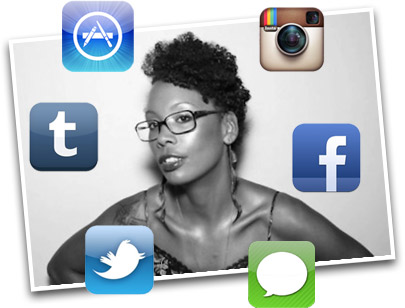Queen of Tech
Alumna Jenna Wortham documents the growing influence of smartphones, apps and the Internet for the New York Times

Jenna Wortham (Col ’04) is a technology reporter for the New York Times where she writes about Internet startups, smartphone apps, social media and tech consumerism. She is also a former writer for Wired magazine and co-founder of Girl Crush, a “zine” about female friendship and admiration. On Twitter, where she has nearly half a million followers, she describes herself as a “GIF maker, news breaker” and as “in an open relationship with the Internet.” Here are just a few of her observations about how technology affects the way we live:
On social media:
“My use of Instagram, Tumblr, Twitter and Facebook has never been greater. But I’m growing tired of seeing everyone’s perfectly framed, glittering nightscapes of the Manhattan skyline, their impeccably prepared meals, those beautifully blurred views of the world from an airplane window seat. I’m getting tired of carefully crafting and sharing them myself …
It’s success theater, and we’ve mastered it. We’ve gotten better at it because it matters more. You never know who is looking or how it might affect your relationships and career down the road, and as a result, we have become more cautious about the version of ourselves that we present to each other and the world.”
On digital etiquette:
“Most of us know that it’s rude to text at the dinner table or talk on the phone while paying for groceries at the store—even if we do it anyway.
But what are the rest of the rules that apply to a world populated by smartphones, tablets, apps and services that turn our private lives inside out, and grant our friends and families round-the-clock access to our comings and goings?
Can you crash a friend’s party that you found out about on Facebook or Instagram? Or send a text during dinner — if it’s under the table? Or should you always excuse yourself and head to the bathroom to do a quick and discreet skim through messages, texts and Twitter messages?”
On concertgoers and their smartphones:
“People pulled out their cameras at the introduction of the show and then again when [the artist] segued into his most popular hits, the peaks in the performance when the energy was at its highest …
Perhaps instead of trying to obsessively document the night, my fellow concertgoers were interested in capturing small snippets of the show to serve as a trigger in the future, reactivating the way they felt during those moments. The videos could augment that physical recollection of the night, rather than serve as a replacement for it.
Of course, plenty of people still try to capture every moment throughout the day; it’s compulsive and endemic of the way we interact and share information about our lives through the social Web. But maybe … we’re starting to overdose on the amount of memories we can reasonably review and adapting our behavior to cope.
Maybe we’re starting to prioritize and selectively capture the flashes that seem most important, most evocative, and most likely to transport us back to the moment when they happened the first time around.”
On the trouble with Twitter in times of crisis:
“During Hurricane Sandy’s peak, Twitter was abuzz with activity, as tens of thousands of people turned to the microblogging service for alerts, updates and real-time reports and photographs of the storm
Trouble is, not all of it was true.
Deliberate falsehoods, including images showing the Statue of Liberty engulfed in ominous clouds and sharks swimming through waterlogged suburban neighborhoods quickly spread through the service, as did word that power would be shut off for the entire city of New York and that the floor of the New York Stock Exchange had been flooded.
Twitter says it cannot possibly regulate the millions of messages on its service, and that a bit of misinformation and mischief is to be expected. But in recent years, the service has become an indispensable funnel of information in critical times for many people, especially for those who lose access to power or cable TV. For them, it can be a crucial lifeline.”
On how new apps help document our lives:
“Timehop and Rewind.me … tap into my social media history and send daily reminders of my past postings, from pictures uploaded to Instagram, the photo-sharing application, to messages on Facebook and Twitter.
At a basic level, these services serve as a cognitive crutch, excavating details about the past that I might not otherwise remember. They offer historical insight into a digital world that is in many ways ephemeral — full of constantly refreshing newsfeeds …
They could usher in a much-needed dose of reality about the permanence of the digital Web, a truth that is hard to grasp when so much of what we post online feels so ephemeral, visible for only a few seconds.
Behaving as if our digital data is fleeting can cause serious trouble, said [S. Shyam] Sundar, [a director of the Media Effects Research Lab at Pennsylvania State University] especially as our offline and online worlds merge. Our actions, documented through the content we share, can have very real effects on what colleges we get into, what jobs we qualify for and what people we meet.
‘We have to start taking seriously the idea of social media as self-representation,’ he said. ‘Social media is no longer just a mirror of the present, but also the past.’”
Letting Go of the Network
Reporter Jenna Wortham talks to writer and tech entrepreneur Anil Dash about the fear and joy of missing out when everyone else is still using their mobile devices.